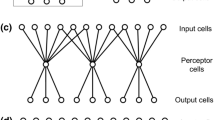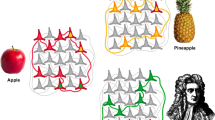Abstract.
Correlation-based learning (CBL) models and self-organizing maps (SOM) are two classes of Hebbian models that have both been proposed to explain the activity-driven formation of cortical maps. Both models differ significantly in the way lateral cortical interactions are treated, leading to different predictions for the formation of receptive fields. The linear CBL models predict that receptive field profiles are determined by the average values and the spatial correlations of the second order of the afferent activity patterns, wheras SOM models map stimulus features. Here, we investigate a class of models which are characterized by a variable degree of lateral competition and which have the CBL and SOM models as limit cases. We show that there exists a critical value for intracortical competition below which the model exhibits CBL properties and above which feature mapping sets in. The class of models is then analyzed with respect to the formation of topographic maps between two layers of neurons. For Gaussian input stimuli we find that localized receptive fields and topographic maps emerge above the critical value for intracortical competition, and we calculate this value as a function of the size of the input stimuli and the range of the lateral interaction function. Additionally, we show that the learning rule can be derived via the optimization of a global cost function in a framework of probabilistic output neurons which represent a set of input stimuli by a sparse code.
Similar content being viewed by others
Author information
Authors and Affiliations
Additional information
Received: 23 June 1999 / Accepted in revised form: 05 November 1999
Rights and permissions
About this article
Cite this article
Piepenbrock, C., Obermayer, K. The effect of intracortical competition on the formation of topographic maps in models of Hebbian learning. Biol Cybern 82, 345–353 (2000). https://doi.org/10.1007/s004220050588
Issue Date:
DOI: https://doi.org/10.1007/s004220050588




